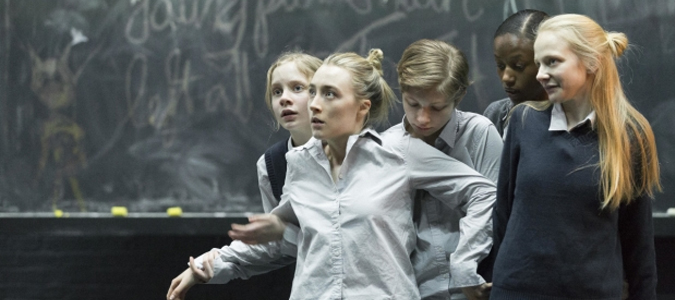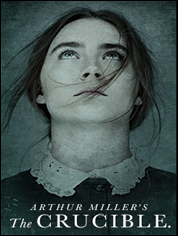

The Crucible
Opening Night: March 31, 2016
Closing: July 17, 2016
Theater: Walter Kerr Theater
Arthur Miller’s “The Crucible” returns to Broadway in a new production directed by the acclaimed Belgian director Ivo van Hove. Set during the Salem witch trials of the 1690s, The Crucible is a timeless parable of morality, a scorching indictment of intolerance, and a central work in the canon of American drama.
BUY TICKETSREAD THE REVIEWS:
March 31, 2016
The Devil has returned to Broadway, with the power to make the strong tremble. It is time to be afraid, very afraid, of a play that seemed perhaps merely worthy when you studied it in high school English class. The director Ivo van Hove and a dazzling international cast — led by Ben Whishaw, Sophie Okonedo, Saoirse Ronan and Ciaran Hinds — have plumbed the raw terror in Arthur Miller’s “The Crucible,” which opened on Thursday night at the Walter Kerr Theater. And an endlessly revived historical drama from 1953 suddenly feels like the freshest, scariest play in town. That its arrival also feels perfectly timed in this presidential election year, when politicians traffic in fears of outsiders and otherness, is less surprising. Miller’s portrait of murderous mass hysteria during the 17th-century Salem witch trials was written to echo the “Red menace” hearings in Washington in the 1950s. Parallels between Miller’s then and latter-day nows have never been hard to reach for. What makes Mr. van Hove’s interpretation so unsettlingly vivid has little to do with literal-minded topicality.
READ THE REVIEWMarch 31, 2016
A lone wolf prowls through Salem, Mass., in Ivo van Hove’s eye-popping and wholly unconventional revival of Arthur Miller’s “The Crucible,” that great dramatic cautionary tale about the perennial dangers of a rampant theocracy fueled by ignorance and mass hysteria. This is not a metaphoric mammal, but a literal beast, actually a lupine-looking canine known as a Tamaskan, that prowls onstage in Act 2, stops center stage and exerts such a force over the proceedings that one fears he might decide to chow down on Row E the same way the dangerous seductress Abigail Williams, played in full-on seduction mode by the excellent young star Saoirse Ronan, eats up Ben Whishaw’s John Proctor, her married quarry. “I have a sense for heat, John,” she says, dressed provocatively in contemporary schoolgirl attire, “and you have drawn me to your window.” Proctor’s moral authority to stop the prosecution of the innocent thus is compromised as surely as a Southern governor submerged in a sex scandal, which was, of course, one of Miller’s central points in 1953, when this play about witch trials could be applied to a political witch hunt of a different kind, when writers and artists named names to save themselves.
READ THE REVIEWMarch 31, 2016
Good things come to those who wait. Remember that. Because it takes a long time for Broadway’s star-studded revival of Arthur Miller’s “The Crucible” to cast a spell. In the end, it does. The final 15 minutes of this play, set amid the Salem witch trials, are built to be shattering and heart-wrenching. And they are, as tormented adulterer John Proctor chooses to give up everything to reclaim his good name. Innovative Belgian director Ivo van Hove’s staging wrings out every devastating drop of power. As for the preceding 135 minutes — not so much. The drama is packed with ideas about truth and power. But as played here, it’s high on talk, but stubbornly low on impact. Most notably, marquee names — Soairse Ronan, Ben Whishaw and Sophie Okonedo — don’t make deep impressions. A feral presence seems an obvious nod to a wolf-pack mentality running amok. A levitation scene simply confounds. And ambient sound by Philip Glass echoes van Hove’s just-wrapped Broadway staging of Miller’s “A View from the Bridge.” Late-17-century Massachusetts is rendered in contemporary terms. That’s fitting. Hysteria — and people saying unbelievable things that are given credence — is all too resonant today.
READ THE REVIEWMarch 31, 2016
After enlivening the downtown theater scene for years with his iconoclastic takes on classic texts, Ivo van Hove continues his bracing entry into the Broadway arena with his second production of an Arthur Miller drama. While “The Crucible” is a very different play from “A View From the Bridge,” which the Belgian avant-garde director staged to ecstatic acclaim earlier in the season, the two works can also be seen as companion-piece tragedies. Both end with an accused man’s wrenching refusal to be stripped of his name. However, in “The Crucible,” that man’s innocence of the crimes with which he is charged adds blistering heat to the corruption of power that Miller so vehemently targeted. Van Hove knows how to channel that heat. Almost operatic in their intensity, his productions are designed to leave audiences agitated and uncomfortable, which is notably the case with this distressing 1953 drama, with its steadily amplified sense of horror and indignation. Like the director’s View From the Bridge, the mesmerizingly acted new production trades the play’s specific period and milieu — the witch trials of Salem, Massachusetts, in 1692 — for a pared-down look and non-naturalistic, indeterminate setting.
READ THE REVIEWMarch 31, 2016
According to one survey of high school lit teachers, The Crucible by Arthur Miller is the most widely taught play, outside of Shakespeare, in American classrooms. (A Raisin in the Sun and Death of a Salesman follow.) Given the way it’s almost universally presented — as a point-by-point mapping of the McCarthy “witch hunts” of the 1940s and ’50s onto the actual witch trials of Puritan Salem in 1692 — it’s probably received by most students, no less than by most theater critics, as cod liver oil, more medicinal than entertaining. Reviews of the 1953 Broadway premiere highlighted Miller’s political passion and daring; the play was certainly a response to, and a kind of baiting of, the House Un-American Activities Committee. But to many, the passion was achieved at the cost of theatrical imagination. George Jean Nathan called The Crucible “an honorable sermon” whose sting had been “disinfected with an editorial tincture.” I wonder what Nathan (and generations of American sophomores) would make of the gripping, emotional revival, directed by the Belgian avant-gardist Ivo van Hove, that opened tonight at the Walter Kerr. (Kerr himself called the play a “mechanical parable” that “lives not in the warmth of humbly observed human souls but in the ideological heat of polemic.”) They would of course recognize the story; the text has been slightly edited, with the permission of the Miller estate, but unless you recently reread it you would hardly notice the disappearance of a few minor characters, such as the homeless woman Sarah Good. It is still a brilliant demonstration of the hysteria to which a repressive society is susceptible, as trumped-up charges of witchcraft ignite a disastrous series of betrayals.
READ THE REVIEW






















